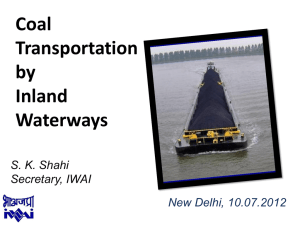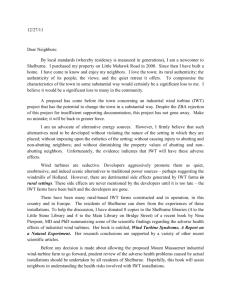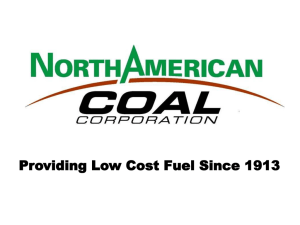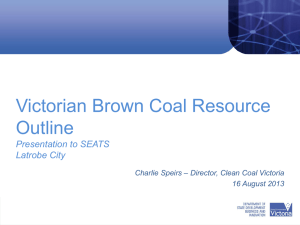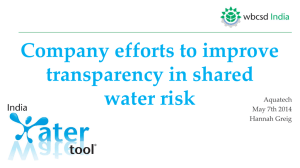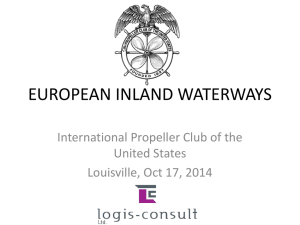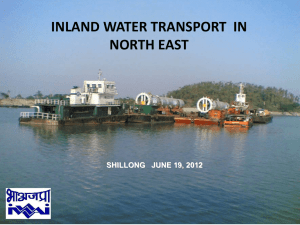event_26-132-1-53f99e913c7d6
advertisement
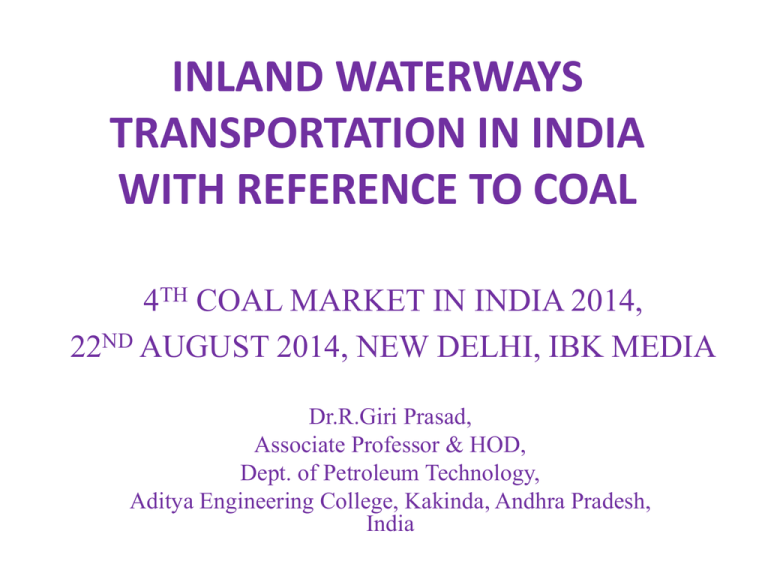
INLAND WATERWAYS TRANSPORTATION IN INDIA WITH REFERENCE TO COAL 4TH COAL MARKET IN INDIA 2014, 22ND AUGUST 2014, NEW DELHI, IBK MEDIA Dr.R.Giri Prasad, Associate Professor & HOD, Dept. of Petroleum Technology, Aditya Engineering College, Kakinda, Andhra Pradesh, India • INTRODUCTION The share of India’s inland water transport (IWT) cargo traffic to the logistics market is significantly lower at 0.5 as compared to China at 8.7 percent, the US at 8.3 percent and Europe at 7 percent. However, the Indian IWT landscape holds immense potential due to its characteristic advantages over other modes of transportation, especially for coal movement. • India has about 14,500 km of navigable inland waterways, of which 5,200 km (36 percent) of major rivers and 485 km (3 percent) of canals are conducive to the movement of mechanised vessels. Among these navigable waterways, five National Waterways (NWs) — NWs 1, 2, 3, 4 and 5, spanning approximately 4,400 km — have been outlined as potential inland waterways at the Ganges and Brahmaputra rivers, the West Coast Canal, the Godavari and Krishna rivers, and the East Coast Canal, respectively. NW 6, which stretches across 121 km, has been proposed on the Barak River. WATERWAYS OF INDIA HISTORY OF INLAND WATER TRANSPORTATION • • • • • • Inland Water Transportation was important mode in the past In 19th century steamers were plying from Kolkata up to Garhmukteshwar and Dibrugarh in the Ganga & Brahmaputra respectively Development of Railways & Roads gave IWT a setback In 1970s, IWT for NER revived with IWT&T Protocol between India & Bangladesh In 1980s and 1990s, CIWTC used to ply vessels from Kolkata to Guwahati and Karimganj routes Transported over 4 lakh tonne cargo in 1989-90, now engaged only in lighter age movement NAGALAND TEJPUR SILGHAT P 31C I N D JOGIGHOPA DHUBRI I A ASSAM PANDU 31 DISPUR 37 P 37 36 INDO – BANGLADESH PROTOCOL ROUTES KOHIMA DAIKHAWA 31 40 SHISHUMARA SHILLONG 51 CHILMARI MEGHALAYA 53 BAHADURABAD 34 MANIPUR ZAKIGANJ SYLHET LAKHIPUR 53 BHANGA KARIMGANJ MARKULI B A N G L A D E S H GODAGARI SIRAJGANJ RAJSHAHI P DHULIAN BAGHABARI IMPHAL P FENCHUGANJ SHERPUR AJMIRIGANJ 54 BHAIRAB BAZAR ARICHA ASHUGANJ 44 TRIPURA DHAKA AKHAURA AGARTALA NARAYANGANJ N AIZWAL MIZORAM P Legend CHANDPUR 2 35 KOLKATA P 6 KHULNA BARISAL P CHALNA KAUKHALI P MONGLA 41 HALDIA ANGTIHARA P NAMKHANA Bay of Bengal Declared National waterway Proposed National waterway Protocol route Road Rail NH 51 Protocol route distances Kolkata - Guwahati/Pandu ...... 1535 km Kolkata - Karimganj...................1318 km Dhulian-Rajshahi...........................78 km 7 Myanmar (Burma) KOTTAPURAM N National Waterway-3 17 West Coast Canal ALUVA (Kottapuram – Kollam) Champakkara & Udyogamandal canals UDYOGAMANDAL CANAL 49 KAKKANAD(CSEZ) CHAMPAKKARA CANAL MARADU KOCHI 47 River distance Kottapuram - Kollam 168 km Udyogamandal canal 23 km Champakkara canal 14 km Total length 205 km VAIKOM K CHERTHALA THANNERMUKKOM LOCK CUM BARRAGE E ALAPPUZHA 220 R A THRIKKUNNAPUZHA THRIKKUNNAPUZHA LOCK GATE L KAYAMKULAM Arabian Sea A CHAVARA KOLLAM 208 Legend Waterway alignment Road Rail Important places Development cost- Rs 1515 cr (2010prices) Notified on 25.11.2008 Development cost- Rs 4210 cr (2010 prices) Notified on 25.11.2008 Proposed National Waterway – 6 : River Barak Length –121 km Development cost -Rs 120 cr (at 2011 prices) Status: Declaration in process Badarpur Bhanga Stretch Km Bhanga - Lakhipur 121 Silchar ROAD AND RAIL NETWORK Roads have always been the primary mode of transport in India. India has one of the largest road networks of approximately 42.36 lakh kms. As per the Road Transport & Highways Department around 60% of the total freight and around 87% of passenger traffic is carried by Indian roads. Traffic is forecasted to grow at around 8-10% p.a. A large portion of railway sidings is single line and is utilized by passenger as well as freight trains. The sharing of railway sidings amongst the passenger and freight trains causes disruption in the smooth functioning of the trains. Long waiting times and uncertainty of arrival are the two primary reasons for the delay in time of freight goods. The overall freight traffic has been continuously rising. Over the last 10 years, traffic has grown at a CAGR of 6.27%. IR‟s available infrastructure does not have enough capacity to cater to this traffic leading to severe network capacity constraints. WORLD COAL RESERVES Ukraine 4% Kazakhstan 4% South Africa 4% Serbia 2% Germany 5% United States 29% India 8% Australia 10% China 14% Russia 20% Coal: demand - supply gap 800 • Power generation capacity: a critical 700 requirement • Coal: the main source 600 of energy 500 • Current coal demand: 400 696 MMT • May become 1000 300 MMT by 2017 • Estimated coal to be 200 imported : 137 MMT 100 696.03 656.31 597.98 550 573.42 535.23 559 497.29 COAL DEMAND(MMT) DOMESTIC (MMT) IMPORTED(MMT) 137.03 52.71 62.75 82.89 0 2008-09 2009-10 2010-11 2011-12 Power Sector Overview Installed Capacity –Fuel wise Renewable Nuclear 3% Installed Capacity [GW] 2007 124 By 2012 190 By 2017 290 By 2022 425 By 2027 575 By 2032 800 10% Hydro 20% Diesel 1% Year Coal 54% Gas 10% Generation Installed Capacity (as on 31.12.2011) : 187 GW INLAND WATER TRANSPORTATION ADVANTAGES One liter of fuel moves (T-km) 105 120 85 Road 80 24 40 Rail Fuel efficiency: One HP moves Kgs 4000 3500 3000 2500 2000 1500 1000 500 0 4000 0 IWT Road Rail IWT Road Rail 150 500 IWT 6 Operating cost (international level) Cents /T km 5.2 4 2.5 1 2 Road Rail IWT Road 0 Road Rail IWT Rail IWT Parameters IWT Rail Road Energy efficiency: 1 4,000 horse power (HP) can move what weight cargo (kg)? 500 150 Fuel efficiency: 1 liter of fuel can move how much freight (ton – km)? 105 85 24 Equivalent single unit carrying capacity 1 barge 15 rail wagons 60 trucks Air pollution Low Medium High Land Acquisition Low High High Capital required Low High High Note: the information is for indicative comparison only, Source: Inland Waterways Authority of India. IWT USAGE OTHER COUNTRIES Coal is the largest commodity by volume moving on waterways –USA’s thermal power plants use waterways for > 20 % of coal –Germany: 45% –China: 17% –India: practically nil Coal transportation bottlenecks • Railway Congestion • Shortage of rakes • Shortage of bottom opening wagons Railway network has its own limitations in terms of zonal capacities, inter-zone re-deployment of rakes, etc. • Port congestion • Low draft at some ports like Haldia Hence, overdependence on railways needs to be reduced: road is out of question : IWT a realistic supplementary option, especially for imported coal Thermal power plants along NW-1 Muzaffarpur 8 14 Barauni Buxar Allahabad 15 19 12 6 Kahalgaon 13 Bhagalpur9 Barh 11 10 18 Bara Karchana 16 17 Anapara Obra 8 THANK YOU Lakhisarai 7 Pirpainti 6 5 Farakka Installed power: around 15,000 MW 20 Total coal requirement: around 75 MMTPA Imported coal: around 15 MMTPA NTPC Plants State Govt Plants Proposed Power Plants Sagardighi 4 Bandel Budge Budge 2 Kolaghat 8 Expansion 3 1 Haldia • NTPC’s TPS at Farakka & Kahalgaon face acute shortage of coal • They require 3-4 MMT of imported coal • But due to several reasons, transportation of this coal has been a difficult and costly proposition for NTPC Draft constraint at Haldia: Available draft-7.0 m High waiting time at Paradip port Limited rake availability for transportation from port High Logistics cost leads to high delivered cost of coal Handling/ transition losses Delayed delivery leading to additional losses After sustained persuasion by IWAI, NTPC gave commitment for transportation of 3 MMTPA imported coal by IWT for these plants for 7 years IWAI & NTPC developed a project with entire funding by private sector Project comprises of: Transhipment equipment at sea; about 40 barges; a terminal at Farakka; and coal conveyors from terminal to coal stack yard at Farakka Approximate cost: Rs 650 crore By open tendering Jindal ITF identified as L1 bidder Tripartite agreement signed among IWAI, NTPC & Jindal ITF on 11.8.11 Supply of coal to start in December, 2012 This could be a path breaking project for IWT in India Support provided by IWAI/NTPC • Guaranteed cargo by NTPC- 3 MMTPA for 7 years • Assurance from IWAI to provide LAD OF 2.5 Mts. between Haldia- Farakka for at least 330 days in a year – Suitable for 1500 T – 2000 T barges • • • • Vertical clearance of 10 Mts. Assured night navigation facility Connectivity through DGPS stations Facilitation of transfer of land at Farakka for terminal JITF PROPOSED SOLUTION Transshipper at high sea Barges on NW-1 Destination : Jetty with grab unloaders at destination Vessel types River Barge Tug and Dumb Barge Estuarine Ship Pushboat and Dumb Barges Conclusion • • • • • • Water is a critical mode of transportation for any economy. Although it is a cost-effective and environment-friendly mode of transport, its share in the modal mix in India is significantly less than that in developed countries. Domestic shipping provides significant fuel and cost savings over road and rail transport and, thus, offers several opportunities to meet the demand for bulk transportation to nearby areas and along the coast, which is highly relevant for India. However, its low penetration in the country is a result of the long period it takes to transport goods, the unavailability of return cargo, lack of awareness of its benefits and various regulatory policies. Only 7 per cent of Indian cargo moves through the water as against more than 40 per cent in China and European Union, despite having rivers and a long coastline. With 10-11 TPS already in the vicinity of NW-1 and 10 more coming up; it will be unfortunate if we still do not use IWT for coal transportation thereon Railways can simply not meet this demand- if waterways are not used, power generation will suffer- there is no other way Haldia- Farakka coal transportation project can therefore be a trailblazer Currently, Indian companies do not use the coastal route because of lack of roads and railways connecting ports to factories or consumption centres. The new government, in its maiden budget, allotted Rs4,200 crore to develop Ganga for inland waterway, giving a major push to coal transportation in the region.
